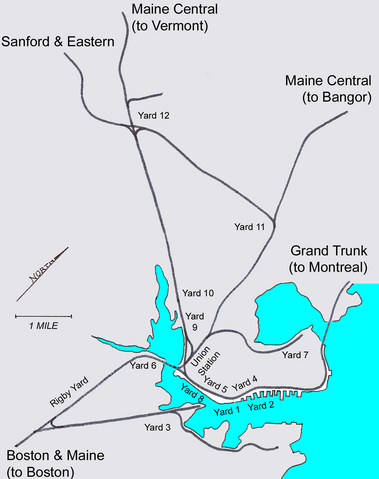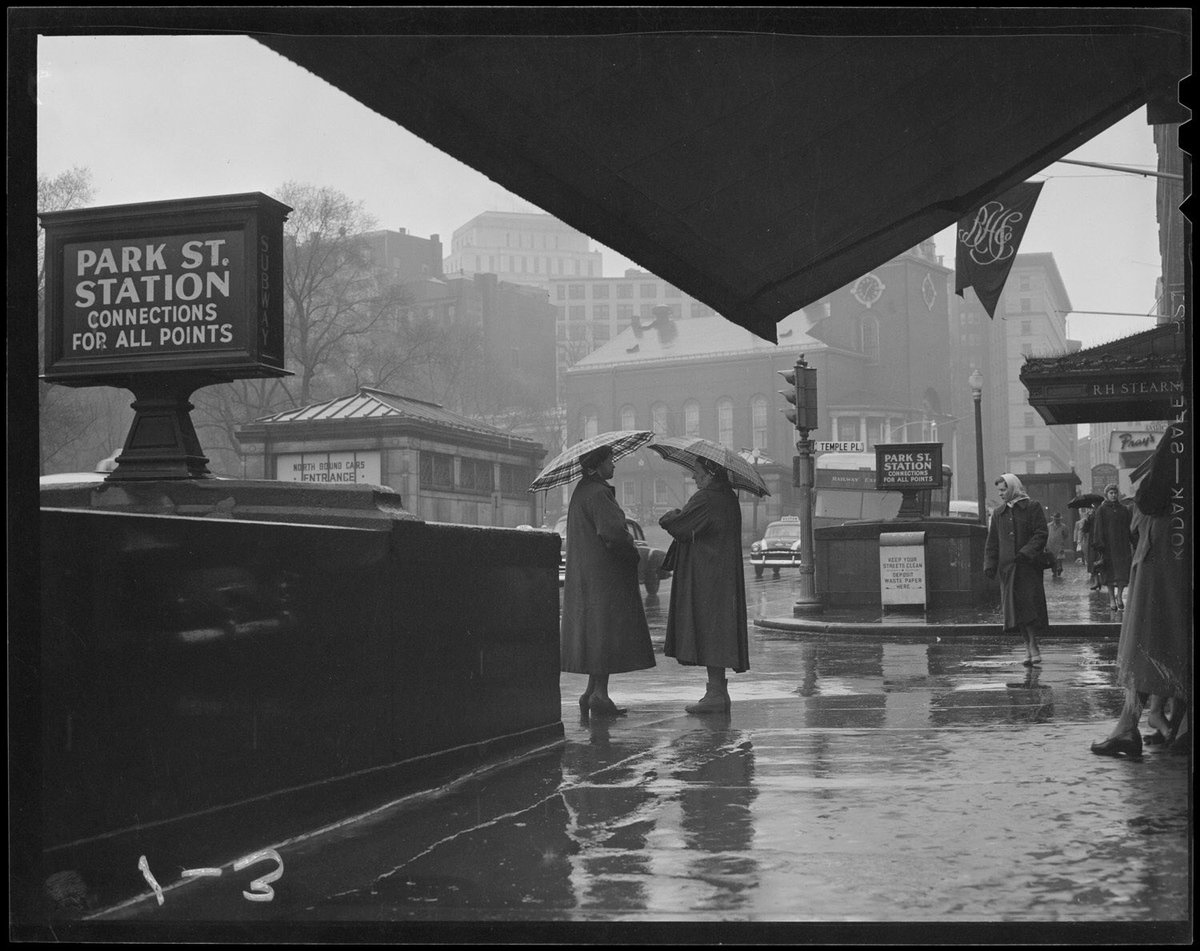Saw this in a different thread. My reply belongs here as it is a crazy transit pitch:
Part 1: Upgrade/extend the existing freight track that lies south of West Commercial Street. Build a new Portland Amtrak station on the peninsula, possibly near the Casco Bay Bridge. By relocating Portland's Amtrak station onto the peninsula, it would make train travel to/from Portland even more desirable. Especially, now that the Downeaster has proven to be such a success.
Part 2: Develop a Portland-based Commuter Rail system. . .
What you're proposing is what existed track-wise from the 1970's prior, when the Yard 8 trackage on the Boston & Maine + Maine Central side (now Pan Am) connected via 12 blocks of street-running track on Commercial St. to the rump-end of the Canadian National track, with the Narrow Gauge Museum now taking up all track south of the burnt-out Back Cove swing bridge. Street-running started a block north of the Casco Bay Bridge and ended at the Franklin St. intersection. CN got into Portland using the Grand Trunk track that crosses the Downeaster at Yarmouth Jct. diamond and runs to the Back Cove swing (all MEDOT-owned and still nominally active, although freight rights expired 3 years ago after the final St. Lawrence & Atlantic rail delivery of raw baked beans to the B&M beans factory abutting the north side of the swing bridge). The Big Three Portland-terminating RR's then pooled resources to joint-fund a terminal-switching carrier,
Portland Terminal Company (which the MEC technically owned) tasked with doing all the unified switching between the RRs' area freight yards. Basically a much larger-scale version of Boston's Union Freight RR up Atlantic Ave. (owned by NYNH&H but likewise with monetary support from the other two biggies B&M and Boston & Albany). And longer-lasting since PTC didn't shutter ops until B&M and MEC came under joint ownership of today's Pan Am in '83 and CN had deserted Portland for the suburbs. The Commercial St. street-running track went derelict and was paved over by about 1990. Yard 8 has been very recently rehabbed by Pan Am for intermodal loads, with the new container truck parking lot and loading queue now by the Casco Bay Bridge underpass.
For obvious reasons it's not terribly practical to make use of the peninsula track because there's no room inside Yard 8 now that it's being regularly used for lucrative intermodal freight. And re-laying street-running track on Commercial is a nonstarter. However, as Portland Terminal Co.'s old system map shows below you do have the 1990's-landbanked Union Branch running alongside present-day I-295 as a different re-use option.

Union Branch split off from the MEC mainline at Park Ave. just past the old Portland Union Station site, where its bridge overpass is still intact and the first 3/4 mile of track to the Forest Ave. exit off 295 is still intact (not even any vegetation overgrowth to belie its 25 years of disuse). After Forest Ave. it slipped onto a side reservation for a few blocks along Kennebec St. (Google shows the northerly sidewalk as being distortedly over-buffered) then passed between buildings onto the alignment of the current Bayside Trail where it fed into "Yard 7", the old CN yard spanning Loring Memorial Park and the sewage treatment plant that also had a track connection to the Grand Trunk main right before the swing bridge. PTC would basically spend all its days making big circles between Commercial St. and the Union Branch shuffling loads between all these yards plus the ones out in the suburbs.
Now...MEDOT has long desired to widen 11 miles of 295 to 6 lanes between Scarborough split with I-95 and Falmouth Spur in Falmouth. It's been *close* but no cigar on funding for 2 decades now, such that it's going to take a leap-of-faith overpay risk to start the ball rolling. But the extra lane capacity is legit needed the way Portland is growing, and would largely be done on the same land footprint by eating the center median. So as add-a-lanes go it's not an induced demand trap and is a sensible greenlight if budgets weren't so statewide tight. Now, the fact that the tracked fragment of Union Branch and active-but-disused Grand Trunk main are in near-eyeshot of the highway through the whole of the add-a-lane project area presents a potentially juicy multimodal opportunity to goose the project's top-line value proposition and make the funding push more palatable. If you reconnected the stet Union Branch west of Forest Ave. the highway rebuild between Forest Ave. and the 1.3 miles to Back Cove presents an opportunity to lay virgin track by the side of the highway, send it across the cove on a widened 295 bridge (bypassing the burned Grand Trunk swing bridge), then hook into the Grand Trunk main @ Kensington St. a few track feet past the baked beans factory. Downeaster + freight main relocate off the MEC alignment onto this new 295 + Grand Trunk alignment out to Yarmouth Jct. Downeaster bangs a right @ Yarmouth towards Freeport on the existing out-of-service east wye, while PAR freights go straight and rejoin their main to Waterville @ Danville Jct. in Auburn. A new Portland Union Station gets sited somewhere within a few blocks of the old Union Station's Congress St. site. Downeaster's reverse move at Thompson's Point goes away forever at tangible schedule gains, and future Portland-area commuter rail can wye its way onto most any alignment from New Union Station.
This isn't even a "Crazy" pitch because so much of the ROW is already available via existing on-the-ground Grand Trunk + Union Branch track or the existing grass median bordering 295's southerly side to the cove. The remaining touches that would tie the corridor together are all taken care of with the highway widening: (1) widened cove bridge with rail berth, (2) compacting of Forest Ave. cloverleaf ramps into a diamond interchange so tracks have straightened shot, (3) new rail overpasses of Forest Ave., Preble St., and Franklin St. adjacent to the rebuilt 295 overpasses. Not much cost increase at all over the solo highway widening project, but would seriously increase its overall upside. Consider the current MEC main has 14 grade crossings inside City of Portland, with 11 coming on 1.9 miles of very dense residential between ME 25 and ME 100. Relocation via 295 to the Grand Trunk alignment whacks 13 out of 14 city crossings. A perfect 14-for-14 if elevating tracks over Congress St. is done in package with this job. Lots of schedule gains to be had there, and huge quality-of-life gains for all that residential. Where, BTW, PAR does transport daily HAZMAT freights through that cluster of 11 crossings. Relocate the passenger & freight mains and the MEC track gets busted down to being used once or twice a week for freight locals to the Bishop St. vicinity, plus once-in-blue-moon alt routings home from Yarmouth Jct. Maybe someday high-frequency circumferential Portland CR can make new use of that alignment with stop spacing dense enough to give something back to the residents around the crossings. 17 miles of redundant PAR main between Royal Jct. and Danville Jct. out in the forest can then be abandoned now that they've switched over to the parallel Grand Trunk alignment between Yarmouth-Danville; Portland will get its closest-proximity 'good' rail trail hike in that exchange.
Additionally, relocating the whole works to the GT main opens up great potential for a Falmouth infill stop on the Downeaster. And you can possibly lay down a wye by the sewage treatment plant to take back the Narrow Gauge Museum track for a 1.5 mile Ferry Terminal stub station that can be served via reverse move on certain Portland-terminating DE slots and/or seasonal high-demand slots where the reverse-move digression (which the DE is certainly no stranger to) is high-leverage enough to go for. Space is there through the park for that connection. If/when Portland CR happens the Ferry Terminal stop can have its service levels further buffed out by being a secondary inner-city terminal to New Union Station.
If 295 add-a-lane is the main megabucks linchpin driving MEDOT decision-making, these rail extras do not add very much above-and-beyond absolute cost at all. But they enormously enrich the transpo capacity and flexibility for all of Greater Portland to do in a package deal, given all the thru-routing benefits to both passengers & freight alike and all the grade separation gains. Not to mention the big, big upside the re-route gifts to future CR in the form of that New Union Station<-->Grand Trunk<-->Yarmouth Junction<-->MEC<-->New Union Station circumferential route lined head-to-foot with multi-directional wye junctions that can be plugged-and-played from all directions.
Total max-leverage build that will pay back its investment in spades, and pay back the 295 widening orders of magnitude faster. I know NNEPRA has kind of been nipping at the fringes of considering re-routes or finding a way to glom rail onto the 295 project, so mental wavelengths are thinking alike amongst planners. But it would be a game-changer if they just up and presented this as 'THE' vision-thing transpo reboot for the city and bulleted out all the above advantages for the public. Momentum would be self-cresting if it had a concerted public sell job applied to it.



